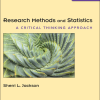Test Bank for Research Methods The Essential Knowledge Base 2nd Edition by William Trochim, James Donnelly, Kanika Arora ISBN 9781133954774 1133954774
$70.00 Original price was: $70.00.$35.00Current price is: $35.00.
Instant download (Test Bank) Research Methods The Essential Knowledge Base 2nd Edition after payment
Test Bank for Research Methods The Essential Knowledge Base 2nd Edition by William Trochim, James Donnelly, Kanika Arora – Ebook PDF Instant Download/Delivery: 9781133954774, 1133954774
Full dowload Research Methods The Essential Knowledge Base 2nd Edition after payment

Product details:
ISBN 10: 1133954774
ISBN 13: 9781133954774
Author: William Trochim, Ph.D.; James P. Donnelly; Kanika Arora
Research Methods: The Essential Knowledge Base
Research Methods The Essential Knowledge Base 2nd Table of contents:
Part 1: Foundations
Chapter 1: Foundations of Research Methods
-
1.1. The Research Enterprise
- 1.1a. What Is Research?
- 1.1b. Translational Research
- 1.1c. Research Syntheses and Guidelines
- 1.1d. Evidence-Based Practice
- 1.1e. An Evolutionary Perspective on the Research Enterprise
-
1.2. Conceptualizing Research
- 1.2a. Where Research Topics Come from
- 1.2b. The Literature Review
- 1.2c. Feasibility Issues
-
1.3. The Language of Research
- 1.3a. Research Vocabulary
- 1.3b. Types of Studies
- 1.3c. Time in Research
- 1.3d. Types of Relationships
- 1.3e. Hypotheses
- 1.3f. Variables
- 1.3g. Types of Data
- 1.3h. The Unit of Analysis
- 1.3i. Deduction and Induction
-
1.4. The Structure of Research
- 1.4a. Components of a Research Study
-
1.5. The Validity of Research
- Summary
- Key Terms
- Suggested Websites
- Review Questions
Chapter 2: Ethics
-
2.1. Foundations of Ethics in Research
-
2.2. Historical Cases of Unethical Research
- 2.2a. Nazi Experimentation during WWII and the Nuremberg Code
- 2.2b. Stanley Milgram’s Obedience Studies
- 2.2c. The Thalidomide Tragedy
- 2.2d. The Tuskegee Syphilis Study
-
2.3. Evolution of a Modern System of Research Ethics
- 2.3a. The Belmont Report
- 2.3b. Related Guidelines on Human Subject Participation
- 2.3c. Institutional Review Boards (IRBs)
- 2.3d. Ethics in Clinical Research: Patient Protection versus Access
- 2.3e. Ethics in Research with Animals
-
2.4. Ethics in the Production and Publication of Scholarly Work
-
2.4a. Honesty in Reporting
-
2.4b. Conflict of Interest
-
2.4c. Fairness in Publication Credit
-
Summary
-
Key Terms
-
Suggested Websites
-
Review Questions
-
Chapter 3: Qualitative Approaches to Research
-
3.1. Foundations of Qualitative Research
-
3.2. The Context for Qualitative Research
- 3.2a. Generating New Theories or Hypotheses
- 3.2b. Developing Detailed Stories to Describe a Phenomenon
- 3.2c. Achieving Deeper Understanding of the Phenomenon
- 3.2d. Improving the Quality of Quantitative Measures
-
3.3. Qualitative Traditions
- 3.3a. Ethnography
- 3.3b. Phenomenology
- 3.3c. Field Research
- 3.3d. Grounded Theory
-
3.4. Qualitative Methods
- 3.4a. Participant Observation
- 3.4b. Direct Observation
- 3.4c. Unstructured Interviewing
- 3.4d. Case Studies
- 3.4e. Focus Groups
- 3.4f. Unobtrusive Methods in Qualitative Research
-
3.5. Qualitative Data
- 3.5a. How Different are Quantitative and Qualitative Data?
-
3.6. Assessing Qualitative Research
-
3.6a. Credibility
-
3.6b. Transferability
-
3.6c. Dependability
-
3.6d. Confirmability
-
Summary
-
Key Terms
-
Suggested Websites
-
Review Questions
-
Part 2: Sampling
Chapter 4: Sampling
-
4.1. Foundations of Sampling
-
4.2. Sampling Terminology
-
4.3. External Validity
- 4.3a. Two Major Approaches to External Validity in Sampling
-
4.4. Sampling Methods
-
4.5. Nonprobability Sampling
- 4.5a. Accidental, Haphazard, or Convenience Sampling
- 4.5b. Purposive Sampling
- 4.5c. Modal Instance Sampling
- 4.5d. Expert Sampling
- 4.5e. Quota Sampling
- 4.5f. Heterogeneity Sampling
- 4.5g. Snowball Sampling
- 4.5h. Summary of Nonprobability Methods
-
4.6. Probability Sampling: Theory
- 4.6a. The Sampling Distribution
- 4.6b. Sampling Error
- 4.6c. The Normal Curve in Sampling
-
4.7. Probability Sampling: Procedures
- 4.7a. Initial Definitions
- 4.7b. Simple Random Sampling
- 4.7c. Stratified Random Sampling
- 4.7d. Systematic Random Sampling
- 4.7e. Cluster (Area) Random Sampling
- 4.7f. Multistage Sampling
- 4.7g. How Big Should the Sample Be?
- 4.7h. Summary of Probabilistic Sampling
-
4.8. Threats to External Validity
-
4.9. Improving External Validity
- Summary
- Key Terms
- Suggested Websites
- Review Questions
Part 3: Measurement
Chapter 5: Introduction to Measurement
-
5.1. Foundations of Measurement
- 5.1a. Levels of Measurement
-
5.2. Quality of Measurement
- 5.2a. Reliability
- 5.2b. Theory of Reliability
- 5.2c. Types of Reliability
- 5.2d. Validity
- 5.2e. Construct Validity and Other Measurement Validity Labels
- 5.2f. Threats to Construct Validity
- 5.2g. The Social Threats to Construct Validity
-
5.3. Integrating Reliability and Validity
- Summary
- Key Terms
- Suggested Websites
- Review Questions
Chapter 6: Scales, Tests, and Indexes
-
6.1. Foundations of Scales, Tests, and Indexes
-
6.2. Scales and Scaling
- 6.2a. General Issues in Scaling
- 6.2b. Purposes of Scaling
- 6.2c. Dimensionality
- 6.2d. Unidimensional or Multidimensional?
-
6.3. Tests
- 6.3a. Validity, Reliability, and Test Construction
- 6.3b. Standardized Tests
- 6.3c. Test Fairness
- 6.3d. How to Find a Good Test
-
6.4. Indexes
-
6.4a. Some Common Indexes
-
6.4b. Constructing an Index
-
Summary
-
Key Terms
-
Suggested Websites
-
Review Questions
-
Chapter 7: Survey Research
-
7.1. Foundations of Survey Research
-
7.2. Types of Survey Research
- 7.2a. Questionnaires
- 7.2b. Interviews
-
7.3. Selecting the Survey Method
- 7.3a. Population Issues
- 7.3b. Sampling Issues
- 7.3c. Question Issues
- 7.3d. Content Issues
- 7.3e. Bias Issues
- 7.3f. Administrative Issues
-
7.4. Survey Design
- 7.4a. Types of Questions
- 7.4b. Question Content
- 7.4c. Response Format
- 7.4d. Question Wording
- 7.4e. Question Placement
- 7.4f. The Golden Rule
-
7.5. Interviews
-
7.5a. The Role of the Interviewer
-
7.5b. Training the Interviewers
-
7.5c. The Interviewer’s Kit
-
7.5d. Conducting the Interview
-
7.5e. Obtaining Adequate Responses—The Probe
-
7.5f. Recording the Response
-
7.5g. Concluding the Interview
-
Summary
-
Key Terms
-
Suggested Websites
-
Review Questions
-
Part 4: Design
Chapter 8: Introduction to Design
- 8.1. Foundations of Design
- 8.2. Research Design and Causality
- 8.2a. Establishing Cause and Effect in Research Design
- 8.2b. Internal Validity
- 8.3. Developing a Research Design
- 8.4. Types of Designs
-
8.4a. Expanding on Basic Designs
-
Summary
-
Key Terms
-
Suggested Websites
-
Review Questions
-
Chapter 9: Experimental Design
-
9.1. Foundations of Experimental Design
-
9.2. Introduction: The Origins of Experimental Design
- 9.2a. Distinguishing Features of Experimental Design
- 9.2b. Experimental Design and Threats to Internal Validity
- 9.2c. Design Notation for a Two-Group Experimental Design
- 9.2d. Difference between Random Selection and Assignment
-
9.3. Classifying Experimental Designs
-
9.4. Signal Enhancing Designs: Factorial Designs
- 9.4a. The Basic 2 × 2 Factorial Design
- 9.4b. Benefits and Limitations of Factorial Designs
- 9.4c. Factorial Design Variations
-
9.5. Noise-Reducing Designs: Randomized Block Designs
-
9.6. Noise-Reducing Designs: Covariance Designs
-
9.7. Hybrid Designs: Switching-Replications Experimental Designs
-
9.8. Limitations of Experimental Design
- Summary
- Key Terms
- Suggested Websites
- Review Questions
Chapter 10: Quasi-Experimental Design
- 10.1. Foundations of Quasi-Experimental Design
- 10.2. The Nonequivalent-Groups Design
- 10.2a. Reaching Cause-and-Effect Conclusions with the NEGD
- 10.3. The Regression-Discontinuity Design
- 10.3a. The Basic RD Design
- 10.3b. The Role of the Comparison Group in RD Designs
- 10.3c. The Internal Validity of the RD Design
- 10.3d. Statistical Power and the RD Design
- 10.3e. Ethics and the RD Design
- 10.4. Other Quasi-Experimental Designs
-
10.4a. The Proxy Pretest Design
-
10.4b. The Separate Pre-Post Samples Design
-
10.4c. The Double-Pretest Design
-
10.4d. The Switching-Replications Design
-
10.4e. The Nonequivalent Dependent Variables (NEDV) Design
-
10.4f. The Regression Point Displacement (RPD) Design
-
Summary
-
Key Terms
-
Suggested Websites
-
Review Questions
-
Part 5: Analysis and Reporting
Chapter 11: Introduction to Data Analysis
- 11.1. Foundations of Data Analysis
- 11.2. Conclusion Validity
- 11.2a. Threats to Conclusion Validity
- 11.2b. Improving Conclusion Validity
- 11.3. Data Preparation
- 11.3a. Logging the Data
- 11.3b. Checking the Data for Accuracy
- 11.3c. Developing a Database Structure
- 11.3d. Entering the Data into the Computer
- 11.3e. Data Transformations
- 11.4. Descriptive Statistics
-
11.4a. The Distribution
-
11.4b. Central Tendency
-
11.4c. Dispersion or Variability
-
11.4d. Correlation
-
Summary
-
Key Terms
-
Suggested Websites
-
Review Questions
-
Chapter 12: Inferential Analysis
- 12.1. Foundations of Analysis for Research Design
- 12.2. Inferential Statistics
- 12.3. General Linear Model
- 12.3a. The Two-Variable Linear Model
- 12.3b. The “General” in the General Linear Model
- 12.3c. Dummy Variables
- 12.3d. The t-Test
- 12.4. Experimental Analysis
- 12.4a. The Two-Group Posttest-Only Randomized Experiment
- 12.4b. Factorial Design Analysis
- 12.4c. Randomized Block Analysis
- 12.4d. Analysis of Covariance
- 12.5. Quasi-Experimental Analysis
-
12.5a. Nonequivalent Groups Analysis
-
12.5b. Regression-Discontinuity Analysis
-
12.5c. Regression Point Displacement Analysis
-
Summary
-
Key Terms
-
Suggested Websites
-
Review Questions
-
Chapter 13: Research Communication
- 13.1. Research Communication
- 13.1a. Research Communication and the Research-Practice Continuum
- 13.1b. General Considerations for Research Communication
- 13.2. The Written Report
- 13.2a. Key Elements and Formatting of a Research Paper
- 13.3. Other Forms of Research Communication
-
13.3a. Presentations
-
13.3b. Posters
-
Summary
-
Key Terms
-
Suggested Websites
-
Review Questions
-
People also search for Research Methods The Essential Knowledge Base 2nd:
research methods the essential knowledge base cengage learning
depth of knowledge activities
types of knowledge base
research methods the basics 3rd edition pdf
research methods knowledge base pdf


